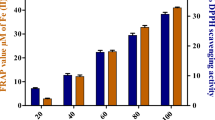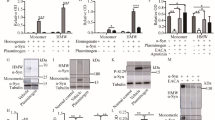Abstract
Transactive response DNA binding protein 43 kDa (TDP-43, encoded by the TARDBP gene) is involved in transcriptional regulation and alternative splicing process. TDP-43 proteins are located in the nucleus and shuttles transcripts to the cytoplasm in normal neurons; however, they are observed in the forms of cytoplasmic inclusions in the degenerating cells. The abnormal accumulation of TDP-43 proteins is a pathologic feature of neurodegenerative diseases, such as Lou Gehrig’s disease and dementia including frontotemporal lobar degeneration and Alzheimer’s disease. In this study, we examined whether schizandrin, a main effective compound of Schisandra chinensis (Turcz.), so called omija in Korean, reduces TDP-43 accumulation in the hippocampal neurons in vitro. An immortalized mouse hippocampal neuronal cell line, HT22 cells, were treated with a proteasome inhibitor, MG132, in the absence or presence of schizandrin. We found that schizandrin treatment increased HT22 cell viability and reduced MG132-induced cytoplasmic accumulation of TDP-43. Our results suggest that schizandrin may be a promising compound for development of functional food materials beneficial to the neuronal protection against TDP-43 proteinopathies.
Similar content being viewed by others
References
Wilson, A. C., B. N. Dugger, D. W. Dickson, and D. S. Wang (2011) TDP-43 in aging and Alzheimer's disease - a review. Int. J. Clin. Exp. Pathol. 4: 147–155.
Ou, S. H., F. Wu, D. Harrich, L. F. Garcia-Martinez, and R. B. Gaynor (1995) Cloning and characterization of a novel cellular protein, TDP-43, that binds to human immunodeficiency virus type 1 TAR DNA sequence motifs. J. Virol. 69: 3584–3596.
Buratti, E. and F. E. Baralle (2001) Characterization and functional implications of the RNA binding properties of nuclear factor TDP-43, a novel splicing regulator of CFTR Exon 9. J. Biol. Chem. 276: 36337–36343.
Wang, H. Y., I. F. Wang, J. Bose, and C. K. Shen (2004) Structural diversity and functional implications of the eukaryotic TDP gene family. Genomics 83: 130–139.
Neumann, M., D. M. Sampathu, L. K. Kwong, A. C. Truax, M. C. Micsenyi, T. T. Chou, J. Bruce, T. Schuck, M. Grossman, C. M. Clark, L. F. McCluskey, B. L. Miller, E. Masliah, I. R. Mackenzie, H. Feldman, W. Feiden, H. A. Kretzschmar, J. Q. Trojanowski, and V. M. Lee (2006) Ubiquitinated TDP-43 in frontotemporal lobar degeneration and amyotrophic lateral sclerosis. Science 314: 130–133.
Ayala, Y. M., P. Zago, A. D'Ambrogio, Y. F. Xu, L. Petrucelli, E. Buratti, and F. E. Baralle (2008) Structural determinants of the cellular localization and shuttling of TDP-43. J. Cell Sci. 121: 3778–3785.
Goedert, M., B. Ghetti, and M. G. Spillantini (2012) Frontotemporal dementia: Implications for understanding Alzheimer disease. Cold Spring Harb. Perspect. Med. 2: a006254.
Tremblay, C., I. St-Amour, J. Schneider, D. A. Bennett, and F. Calon (2011) Accumulation of transactive response DNA binding protein 43 in mild cognitive impairment and Alzheimer disease. J. Neuropathol. Exp. Neurol. 70: 788–798.
Gendron, T. F., K. A. Josephs, and L. Petrucelli (2010) Review: Transactive response DNA-binding protein 43 (TDP-43): Mechanisms of neurodegeneration. Neuropathol. Appl. Neurobiol. 36: 97–112.
Liu-Yesucevitz, L., A. Bilgutay, Y. J. Zhang, T. Vanderweyde, A. Citro, T. Mehta, N. Zaarur, A. McKee, R. Bowser, M. Sherman, L. Petrucelli, and B. Wolozin (2010) Tar DNA binding protein-43 (TDP-43) associates with stress granules: Analysis of cultured cells and pathological brain tissue. PloS One 5: e13250.
Youmans, K. L. and B. Wolozin (2012) TDP-43: A new player on the AD field? Exp. Neurol. 237: 90–95.
Chen-Plotkin, A. S., V. M. Lee, and J. Q. Trojanowski (2010) TAR DNA-binding protein 43 in neurodegenerative disease. Nat. Rev. Neurol. 6: 211–220.
Kwong, L. K., K. Uryu, J. Q. Trojanowski, and V. M. Lee (2008) TDP-43 proteinopathies: Neurodegenerative protein misfolding diseases without amyloidosis. Neurosignals 16: 41–51.
Cheng, H. Y., M. T. Hsieh, C. R. Wu, F. H. Tsai, T. C. Lu, C. C. Hsieh, W. C. Li, Y. T. Lin, and W. H. Peng (2008) Schizandrin protects primary cultures of rat cortical cells from glutamateinduced excitotoxicity. J. Pharmacol. Sci. 107: 21–31.
Lee, M. S., J. Chao, J. C. Yen, L. W. Lin, F. S. Tsai, M. T. Hsieh, W. H. Peng, and H. Y. Cheng (2012) Schizandrin protects primary rat cortical cell cultures from glutamate-induced apoptosis by inhibiting activation of the MAPK family and the mitochondria dependent pathway. Molecules 18: 354–372.
Liu, W., R. Yu, J. Wu, and H. Luo (2006) Gamma-Schisandrin inhibits production of amyloid beta-protein 42 in M146L cells. Yao xue xue bao 41: 1136–1140.
Song, J. X., X. Lin, R. N. Wong, S. C. Sze, Y. Tong, P. C. Shaw, and Y. B. Zhang (2011) Protective effects of dibenzocyclooctadiene lignans from Schisandra chinensis against beta-amyloid and homocysteine neurotoxicity in PC12 cells. Phytother. Res. 25: 435–443.
Wang, B. and X. M. Wang (2009) Schisandrin B protects rat cortical neurons against Aß1–42-induced neurotoxicity. Pharmazie 64: 450–454.
Oh, J., S. B. Jeon, Y. Lee, H. Lee, J. Kim, B. R. Kwon, K. Y. Yu, J. D. Cha, S. M. Hwang, K. M. Choi, and Y. S. Jeong (2015) Fermented red ginseng extract inhibits cancer cell proliferation and viability. J. Med. Food 18: 421–428.
Oh, J., G. J. Daniels, L. S. Chiou, E. A. Ye, Y. S. Jeong, and D. S. Sakaguchi (2014) Multipotent adult hippocampal progenitor cells maintained as neurospheres favor differentiation toward glial lineages. Biotechnol. J. 9: 921–933.
Ikeya, Y., H. Taguchi, I. Yosioka, and H. Kobayashi (1979) The constituents of Schizandra chinensis Baill. I. Isolation and structure determination of five new lignans, gomisin A, B, C, F and G, and the absolute structure of schizandrin. Chem. Pharm. Bull. 27: 1383–1394.
Park, S. Y., S. J. Park, T. G. Park, S. Rajasekar, S. J. Lee, and Y. W. Choi (2013) Schizandrin C exerts anti-neuroinflammatory effects by upregulating phase II detoxifying/antioxidant enzymes in microglia. Int. Immunopharmacol. 17: 415–426.
Egashira, N., K. Kurauchi, K. Iwasaki, K. Mishima, K. Orito, R. Oishi, and M. Fujiwara (2008) Schizandrin reverses memory impairment in rats. Phytother. Res. 22: 49–52.
Hu, D., Y, Cao, R. He, N. Han, Z. Liu, L. Miao, and J. Yin (2012) Schizandrin, an antioxidant lignan from Schisandra chinensis, ameliorates Abeta1-42-induced memory impairment in mice. Oxid. Med. Cell. Longev. 2012: 721721.
van Eersel, J., Y. D. Ke, A. Gladbach, M. Bi, J. Götz, J. J. Kril, and L. M. Ittner (2011) Cytoplasmic accumulation and aggregation of TDP-43 upon proteasome inhibition in cultured neurons. PLoS One 6: e22850.
Arai, T., M. Hasegawa, H. Akiyama, K. Ikeda, T. Nonaka, H. Mori, D. Mann, K. Tsuchiya, M. Yoshida, Y. Hashizume, and T. Oda (2006) TDP-43 is a component of ubiquitin-positive taunegative inclusions in frontotemporal lobar degeneration and amyotrophic lateral sclerosis. Biochem. Biophys. Res. Commun. 351: 602–611.
Amador-Ortiz, C., W. L. Lin, Z. Ahmed, D. Personett, P. Davies, R. Duara, N. R. Graff-Radford, M. L. Hutton, and D. W. Dickson (2007) TDP-43 immunoreactivity in hippocampal sclerosis and Alzheimer's disease. Ann. Neurol. 61: 435–445.
Uryu, K., H. Nakashima-Yasuda, M. S. Forman, L. K. Kwong, C. M. Clark, M. Grossman, B. L. Miller, H. A. Kretzschmar, V. M. Lee, J. Q. Trojanowski, and M. Neumann (2008) Concomitant TAR-DNA-binding protein 43 pathology is present in Alzheimer disease and corticobasal degeneration but not in other tauopathies. J. Neuropathol. Exp. Neurol. 67: 555–564.
Kadokura, A., T. Yamazaki, C. A. Lemere, M. Takatama, and K. Okamoto (2009) Regional distribution of TDP-43 inclusions in Alzheimer disease (AD) brains: Their relation to AD common pathology. Neuropathol. 29: 566–573.
Mackenzie, I. R. and R. Rademakers (2008) The role of transactive response DNA-binding protein-43 in amyotrophic lateral sclerosis and frontotemporal dementia. Curr. Opin. Neurol. 21: 693–700.
Author information
Authors and Affiliations
Corresponding author
Rights and permissions
About this article
Cite this article
Oh, J., Lee, N.K. Schizandrin reduces cytoplasmic TDP-43 accumulation in hippocampal neuronal cells. Biotechnol Bioproc E 22, 9–13 (2017). https://doi.org/10.1007/s12257-016-0656-9
Received:
Accepted:
Published:
Issue Date:
DOI: https://doi.org/10.1007/s12257-016-0656-9




